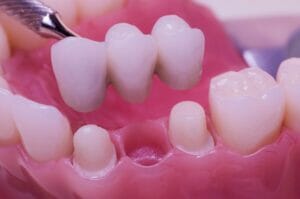
Yet, while dental bridges are common and can last a long time, occasional problems can occur. When they do, you need to know what to do to fix them. Most times, it will require a trip to your dentist for an evaluation, treatment, and possibly even replacement of the bridge itself.
What is a Dental Bridge?
A dental bridge is a replacement device for one or more missing teeth. It is secured to implants, crowns, or natural teeth on each end and functions much like your surrounding teeth, allowing you to eat, smile, and speak normally. These bridges come in both fixed and removable options.
Dental bridges also closely match the color of your surrounding teeth and are custom-fitted for each patient’s mouth. While they are durable and long-lasting, wear and tear may require you to replace them at some point during your lifetime.
5 Common Dental Bridge Problems and How to Fix Them
While beneficial, problems with your dental bridge can still arise at any time. Here are five of the most common dental bridge problems and what may be required to fix them.
1. Ill-Fitting Issues
It is essential to have a custom-made and fitted dental bridge for your mouth. When ill-fitted for one reason or another, discomfort is only the beginning of how it can affect you. Gum irritation can quickly occur, causing infection, raised boils, and recession of the gums, all occurring around the area of the bridge.
To fix this situation and treat those irritations, you will need to schedule an appointment with your dentist. Perhaps the bridge became warped or damaged and no longer fits, or it never truly fit well in the first place.
2. Increased Levels of Tooth Sensitivity
Some tooth sensitivity on either side of the dental bridge is common for patients following the initial procedure. The discomfort is understandable because it is during this time that your mouth is still healing and you are getting used to the restoration itself.
If the sensitivity persists for longer than two weeks or increases in intensity, however, call your dental office and tell them what is going on. The dental bridge may not be fitting correctly within your mouth, or it may be the wrong option for you.
3. Developing Tooth Decay
Dental bridges are no different than your natural teeth when it comes to the need for good oral hygiene. Since the bridge is secured to crowns, implants, or your natural teeth on each end, tooth decay can develop in these areas. If this decay is left and becomes extreme, that tooth on either end may no longer be stable enough to hold the bridge in place.
Decay can also develop around or under the bridge and eventually lead to the need to replace it. Brushing and flossing daily can help prevent this, along with visits to your dentist for professional cleanings and dental exams. You can also use a denture cleaner to brush the bridge but be sure to ask your dentist first how to proceed and whether to leave the cleaner on overnight.
4. Cracks in the Anchoring Tooth
Cracks can occur in the teeth that anchor the bridge in place. These cracks may start out small and mostly invisible but still cause an increase in tooth sensitivity. In addition, bacteria can seep in through these cracks and make their way into the nerves and gums, potentially leading to infection. Your dentist may find these during an exam, or you may feel discomfort and need to make an appointment to find out what is going on.
5. Damage to the Dental Bridge Itself
Dental bridges are made of strong, durable materials, such as metal, porcelain, or a ceramic combination, but they are not indestructible. Damage can occur as a result of rinsing the bridge in hot water (which can cause warping), eating hard or sticky foods, or experiencing trauma to the area of the mouth, such as often happens during sports participation or car accidents.
When damage does occur to the dental bridge itself, it will need replacing. Otherwise, you can suffer oral health issues, including gum disease and infection.
Find Out More About Dental Bridges at Stiles Dental Care
Maintaining your oral health in the most beneficial and comfortable way is important to Dr. Stiles and his team here at Stiles Dental Care. We never want our patients to suffer discomfort or pain from an ill-fitting dental bridge or any other issue. If you are experiencing trouble with your dental bridge or just would like us to make sure it is performing at its best, contact our office and schedule an appointment today.
